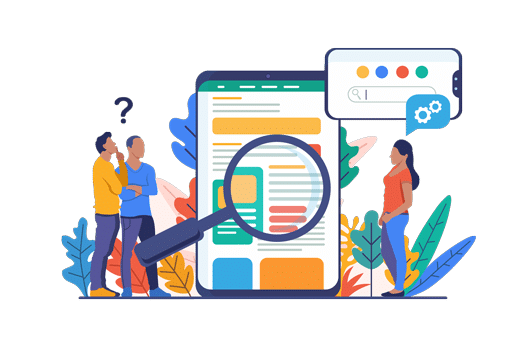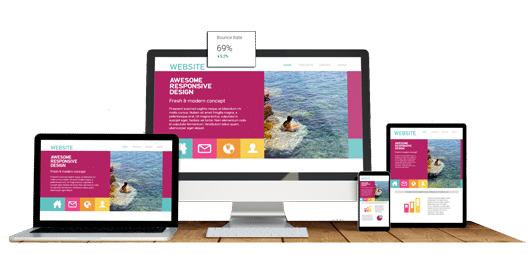Responsive web design is a must-have for all businesses, as global mobile data traffic is expected to increase sevenfold between 2017 and 2022. As of April 2018, the global mobile population amounted to over 4 billion unique users. If your website isn’t optimized for these users, you’re missing out on a lot of business.
With a responsive website, you can make sure your website is optimized for any visitor.
Instead of missing out on potential sales, you can create a better user experience for visitors. Whether they’re on a desktop or mobile device, your customers will have an easy time exploring with responsive web design.
Still on the fence about updating your site? Keep reading to discover the pros and cons of responsive web development. With this list, you can make an informed decision before giving your site the upgrade it needs.
Get started with this comprehensive guide on responsive web design!
The Pros
People spend over 3.3 hours on their phones every single day. With responsive web design, you can reach these consumers while they’re using smaller screens.
What is a responsive website, exactly?
Responsive design uses grid systems, or fluid grids, that scale the website based on the user’s screen. With a responsive site, every page element will resize in relation to one another depending on the device.
Fluid grids are only one part of the equation. You’ll also need to consider CSS styles and media queries. These queries allow sites to collect data from your users before conditionally applying CSS styles.
One of the biggest challenges for responsive sites is keeping images flexible. Otherwise, photos will look awkward when they’re resized for smaller or bigger screens.
Here are a few advantages of responsive web development to consider before updating your website.
1. Increase Mobile Traffic
As more people spend time on their phones instead of desktop devices, you need to start prioritizing your mobile visitors. Otherwise, you could miss out on leads and online sales.
With responsive web design, you can give your mobile customers the chance to fully experience your website. A non-responsive site on a mobile device can display distorted images and uneven text. Navigating through these sites on smaller screens can get frustrating, causing people to leave your site.

By updating your website for mobile devices, you can also improve your search engine optimization (SEO). SEO allows you to rank higher on search engines like Google. As more people see your website, you can start attracting more website traffic.
With a responsive website, you can keep your mobile visitors happy. If they suggest your business to friends and family, you can gain even more traffic!
2. Faster, Cheaper Mobile Development
Previously, many companies chose to create a separate mobile version of their website. This version of the site appeared when a smaller screen size was detected. However, creating a duplicate version of your website means it takes twice as long to make updates.
Developing and maintaining a mobile version of your website is time-consuming.
You’ll also have to pay a developer twice as much since they’ll need to develop two websites instead of one.
With a responsive website, you only have to make design, development, and content updates once.
3. Lower Maintenance Needs
You can’t forget to update your website throughout the year. Plugins, security protocols, design elements, and content require updates every few months. Left unchecked, you could leave your website vulnerable to hackers.
With two versions of your websites, you’ll need to divide time, energy, and your budget between the two.
With a responsive website, you can focus your time on a single site. Then, you can use that extra time to improve your marketing, customer service, content, and more.
4. Fast Load Times
70% of consumers say page speed impacts their willingness to buy from a brand. Responsive web design will ensure your website loads quickly on all devices.
Fluid grins and responsive images will take less time to load on the page.

When people have to wait around, they become frustrated. People abandon websites when they take more than a few seconds to load. By improving your load times, you can keep visitors on your site longer.
5. Lower Bounce Rates
When people fail to click around your website before leaving, it increases your bounce rate. A high bounce rate can impact your search engine ranking. It also means people aren’t converting on your site.
By improving the user experience (UX), you can keep visitors from feeling frustrated.

Then, they’re more likely to explore and engage in your site.
6. More Conversions
As people explore your site, they’re more likely to convert into a lead as well. A non-responsive website, however, can make it difficult for people to fill out forms or make online purchases.
Responsive web design can help you optimize your site for conversions so you don’t miss out!
7. Improved SEO
Google now uses mobile-first indexing to determine your website ranking. If your site isn’t adapted for mobile devices, you won’t reach the top of a Google page.

SEO allows you to rank higher on search engines than your competitors. A higher ranking improves your brand awareness and credibility. By using responsive design, you’re gaining more traffic and strengthening your brand.
The Cons
There are a few negative aspects of responsive design. Here are a few cons to consider before updating your site.
1. Bad Compatibility
Are your website visitors using old versions of Internet Explorer? Older versions aren’t compatible with responsive design, so it’s not recommended. Updating your pages for responsive web design could hurt the UX for these visitors.
2. Time-Consuming
If you don’t have an experienced developer on your team, converting your website to responsive design can become time-consuming.
An experienced web design company can help convert your site or create a new one.
3. It Changes the Layout
Responsive web design can impact your website’s existing layout.
In some cases, it’s better to start from scratch for a new, responsive site.
The Pros & Cons of Investing in Responsive Web Design
Investing in responsive web design can benefit your company in the long-term. By improving your SEO and expanding your brand, you can attract new visitors (and paying customers). Otherwise, you’re missing out.
Ready to get started? Contact us today to discuss your new website!

Share This Article
Choose Your Platform: Facebook Twitter Google Plus Linkedin